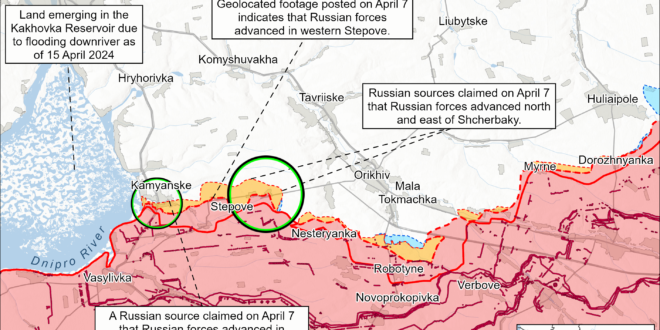The Kremlin continues to deny the legitimacy of the Ukrainian government as part of efforts to claim that Ukraine is not a legitimate negotiating partner and to demand Ukrainian regime change and demilitarization. Kremlin Spokesperson Dmitry Peskov claimed on April 7 that Russian President Vladimir Putin supports the idea of a ceasefire in Ukraine but claimed that several issues “are hanging in the air.”[1] Peskov claimed that these issues include the “lack of control” over the Ukrainian government and the Ukrainian government’s alleged inability to control the actions of unspecified extremist and nationalist units that “simply do not obey” the Ukrainian government’s orders. Peskov claimed that these units are connected to “plans for the further militarization” of Ukraine. Peskov is promoting Putin’s March 28 narrative falsely claiming that the current Ukrainian government is illegitimate and incapable of combatting neo-Nazi groups, which Putin claimed have the “actual power in their hands.”[2] These Kremlin statements are part of a broader effort to undermine the Ukrainian government’s legitimacy and repackage Russia’s long-standing demands for regime change and demilitarization in Ukraine. Putin and other Russian officials previously temporarily paused promoting claims about Ukraine’s alleged illegitimacy following Putin’s phone call with US President Donald Trump on February 12, but later resumed these claims on March 28.[3] Trump recently expressed dissatisfaction with Putin’s disparaging remarks attacking Ukrainian President Volodymyr Zelensky’s legitimacy and expressed a willingness to impose additional sanctions on Russia if the United States and Russia are unable to “make a deal.”[4]
Ukrainian officials did not report any Russian long-range missile or drone strikes on the night of April 6 to 7 or during the day on April 7 following Russia’s largest strike package in over a month on the night of April 5 to 6. It remains unclear why the Russian forces did not conduct any long-range strikes, after having done so daily since December 12, 2024.[5] Russia used the large-scale missile and drone strike series on the night of April 5 to 6 to experiment with its strike packages to increase their effectiveness, and Russia may be preparing to conduct another large-scale strike package in the near future.[6]
Ukraine’s European allies continue to ramp up domestic materiel production and address shortages inhibiting artillery ammunition production. German arms manufacturer Rheinmetall announced on April 7 that the company will acquire and repurpose German nitrocellulose producer “Hagerdorn-NC” for weapons production as part of ongoing efforts to increase Rheinmetall’s capacity for manufacturing ammunition propellants, particularly for 155mm artillery shells.[7] Nitrocellulose, also known as guncotton, is a crucial component of propellants for modern artillery ammunition and other munitions that use gunpowder.[8] Rheinmetall currently produces nitrocellulose at facilities in Switzerland, Spain, and South Africa and plans to increase its production of gunpowder by over 50 percent by 2028.[9] Rheinmetall subsidiary Nitrochemie Aschau — which produces nitrocellulose, other gunpowder components, and dynamite — has increased its production capacity by 60 percent since the start of Russia’s full-scale invasion of Ukraine in 2022 and plans for another 40 percent increase by mid-2025.[10] Rheinmetall CEO Armin Papperger and Saab CEO Micael Johansson warned in April 2024 that the People’s Republic of China (PRC) supplied an overwhelming majority of European ammunition components, including those necessary for nitrocellulose, resulting in bottlenecks inhibiting European artillery ammunition production.[11] Bloomberg reported in March 2025 that Rheinmetall expanded its sourcing of cotton linters — a key component for nitrocellulose production that faced a critical shortage in Spring 2024 — from Europe and countries friendly to the European Union (EU) and built up a stockpile of several years’ worth of linters.[12] NATO General Secretary Mark Rutte told CBS News on April 7 that he has urged US and European leaders to ramp up defense spending and defense industrial production amid concerns of future Russian aggression against Europe.[13] Rutte noted that NATO states combined manufacture four times fewer ammunition rounds than Russia manufactures on its own, despite the fact that NATO’s combined economy is 20 times larger than Russia’s.
Russian authorities likely facilitated the removal of a prominent Russian insider source from Telegram as part of continued efforts to crack down on the Russian information space. Russian insider channel VChK-OGPU-Reserve claimed on April 7 that Telegram administrators deleted the original VChK-OGPU channel and several other channels at the behest of Russian authorities.[14] The other affected channels reportedly include pro-Ukrainian channels and channels publishing information about Kursk Oblast and migrants in Russia — two topics the Kremlin has previously sought to censor.[15] Telegram denied taking down the VChK-OGPU channel and stated that the channel’s administrators deleted their own channel.[16] Other Russian sources claimed that only Telegram has the ability to take down the channel, and one milblogger claimed that the VChK-OGPU administrators may have fallen victim to a phishing scam — a claim which the VChK-OGPU-Reserve channel denied.[17] VChK-OGPU is reportedly affiliated with Russian law enforcement and has offered purported insights into Kremlin factional dynamics, internal assessments of Russian government policies, significant changes in the Russian Ministry of Defense (MoD), and leaks of information regarding the MoD and Russian military.[18] Russian authorities arrested an alleged administrator of VChK-OGPU in February 2023 and designated the VChK-OGPU channel a “foreign agent” in July 2024 at a time when the Kremlin was intensifying its effort to deanonymize Russian Telegram channels and take more direct control over the Russian information space.[19] The Kremlin, if responsible for the channel’s removal, is likely aiming to exert control over the remaining facets of the Russian information space that publish criticisms of the Kremlin or information deemed sensitive. Many Russian ultranationalist milbloggers responded positively on April 7 to the removal of the VChK-OGPU channel, demonstrating the extent to which the Kremlin has already coopted much of the ultranationalist information space and conditioned many milbloggers to accept and promote the Kremlin’s censorship.[20]
Key Takeaways:
The Kremlin continues to deny the legitimacy of the Ukrainian government as part of efforts to claim that Ukraine is not a legitimate negotiating partner and to demand Ukrainian regime change and demilitarization.
Ukrainian officials did not report any Russian long-range missile or drone strikes on the night of April 6 to 7 or during the day on April 7 following Russia's largest strike package in over a month on the night of April 5 to 6.
Ukraine's European allies continue to ramp up domestic materiel production and address shortages inhibiting artillery ammunition production.
Russian authorities likely facilitated the removal of a prominent Russian insider source from Telegram as part of continued efforts to crack down on the Russian information space.
Russian forces recently advanced in Belogorod Oblast and near Siversk, Toretsk, Pokrovsk, and Velyka Novosilka and in western Zaporizhia Oblast.
The Kremlin continues to use its "Time of Heroes" program to militarize regional governments and society in occupied Ukraine.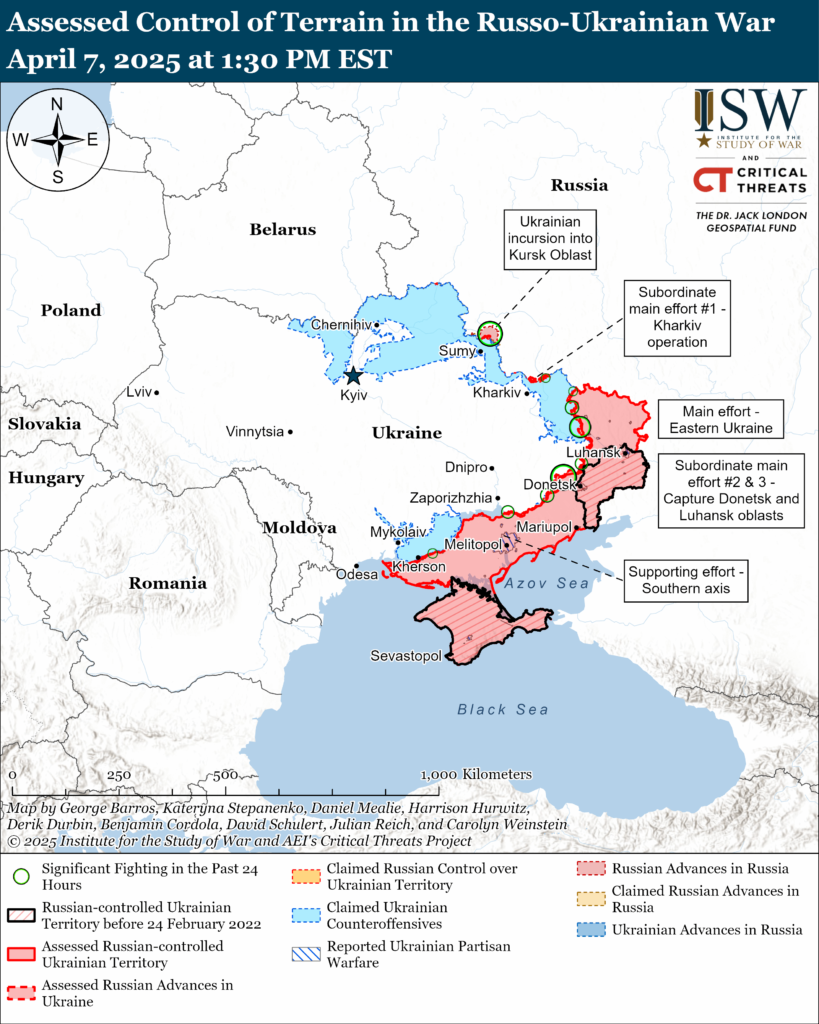
We do not report in detail on Russian war crimes because these activities are well-covered in Western media and do not directly affect the military operations we are assessing and forecasting. We will continue to evaluate and report on the effects of these criminal activities on the Ukrainian military and the Ukrainian population and specifically on combat in Ukrainian urban areas. We utterly condemn Russian violations of the laws of armed conflict and the Geneva Conventions and crimes against humanity even though we do not describe them in these reports.
Ukrainian Operations in the Russian Federation
Russian Main Effort – Eastern Ukraine (comprised of three subordinate main efforts)
Russian Subordinate Main Effort #1 – Push Ukrainian forces back from the international border with Belgorod Oblast and approach to within tube artillery range of Kharkiv City
Russian Subordinate Main Effort #2 – Capture the remainder of Luhansk Oblast and push westward into eastern Kharkiv Oblast and encircle northern Donetsk Oblast
Russian Subordinate Main Effort #3 – Capture the entirety of Donetsk Oblast
Russian Supporting Effort – Southern Axis
Russian Air, Missile, and Drone Campaign
Russian Mobilization and Force Generation Efforts
Russian Technological Adaptations
Activities in Russian-occupied areas
Significant Activity in BelarusAlleged Ceasefire Violations
Ukraine and Russia have not yet concluded a maritime ceasefire agreement due to ongoing Russian demands for Western sanctions relief. Negotiations regarding the conditions of the ceasefire on strikes against energy infrastructure are ongoing, and the resolution of these negotiations remains unclear.
The Russian Ministry of Defense (MoD) claimed without evidence on April 7 that Ukrainian forces conducted six strikes against Russian energy infrastructure facilities in Rostov, Voronezh, and Bryansk oblasts and in occupied Crimea and Donetsk and Kherson oblasts.[21]
Ukrainian Operations in the Russian Federation
Russian forces recently advanced in Kursk Oblast amid continued fighting in the Kursk-Sumy Oblast border area.
Assessed Russian advances: Geolocated footage published on April 7 indicates that Russian forces recently advanced to western and southern Guyevo, Kursk Oblast (south of Sudzha).[22] Some Russian milbloggers claimed that Russian forces seized and cleared Guyevo, while others claimed that Ukrainian forces still maintain positions within and on the outskirts of the settlement.[23]
Unconfirmed claims: Russian milbloggers continued to claim that Russian forces seized Basivka, Sumy Oblast (northeast of Sumy City).[24] Ukrainian Center for Countering Disinformation Head Lieutenant Andriy Kovalenko stated on April 6 that Russian forces do not occupy Basivka, however.[25] Russian sources claimed that Russian forces advanced southeast of Basivka and to the northern outskirts of Loknya, Sumy Oblast (just south of Basivka).[26]
Fighting continued in Kursk Oblast near Guyevo, Oleshnya (northwest of Guyevo along the international border), and Gornal (southwest of Guyevo near the international border) and in Sumy Oblast near Basivka and Loknya.[27] A Russian source claimed that Ukrainian forces maintain positions near Oleshnya and Gornal.[28]
The co-founder of a Ukrainian source reportedly affiliated with Ukrainian military intelligence stated that Russian forces are attacking Basivka in small assault groups and on buggies in order to take shelter in the settlement.[29] Ukraine’s Siversk Group of Forces Spokesperson Vadym Mysnyk reported on April 7 that Russian shelling of the border areas of Chernihiv, Sumy, and part of Kharkiv oblasts have sharply decreased in the past day and that Russian attacks in the area have decreased by about two times, likely due to changing weather conditions and Ukrainian strikes against Russian ground lines of communication (GLOCs).[30] Mysnyk stated that there are no indications that Russian forces are forming large-scale force groupings in the area.
Ukraine’s Unmanned Systems Forces (USF) reported on April 7 that elements of the USF struck three Russian Buk air defense systems in the Kursk direction within 12 hours.[31] The USF reported that Ukrainian forces conducted drone strikes against two Buk-M3 air defense system launchers, damaging the radars, and against one Buk-M2 launcher, detonating its missiles and destroying the launcher.
Order of Battle: Elements of the Russian BARS-Sarmat (Russian Army Combat Reserve) and 177th Naval Infantry Regiment (Caspian Flotilla) are reportedly operating in Kursk Oblast.[32] Drone operators of the 810th Naval Infantry Brigade (Black Sea Fleet) are reportedly operating near Gornal.[33]

Russian forces recently advanced in Belgorod Oblast.
Assessed Russian advances: Geolocated footage published on April 7 indicates that Russian forces recently advanced in central Demidovka (northwest of Belgorod City).[34]
Unconfirmed claims: Russian milbloggers claimed that Russian forces pushed Ukrainian forces out of Demidovka and Popovka (northwest of Demidovka).[35] One Russian milblogger claimed that Ukrainian forces maintain positions in Demidovka, and another claimed that Demidovka is a contested “gray zone.”[36]
Fighting continued near Popovka and Demidovka.[37]
A Russian milblogger claimed that Russian forces are using first-person view (FPV) drones with fiber optic cables to counter Ukrainian electronic warfare (EW) systems in the Belgorod direction.[38]
Order of Battle: Elements of the Russian 34th Motorized Rifle Brigade (49th Combined Arms Army [CAA], Southern Military District [SMD]) and 155th Naval Infantry Brigade (Pacific Fleet) are reportedly operating near Popovka.[39]
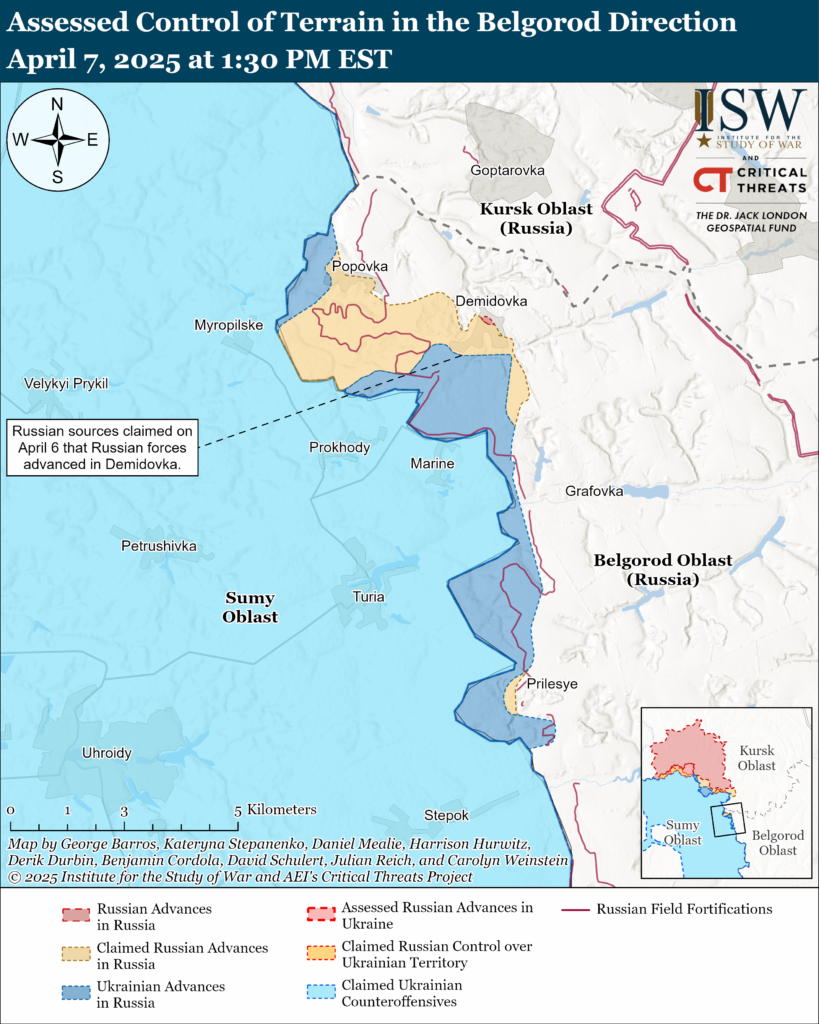
Russian Main Effort – Eastern Ukraine
Russian Subordinate Main Effort #1 – Kharkiv Oblast (Russian objective: Push Ukrainian forces back from the international border with Belgorod Oblast and approach to within tube artillery range of Kharkiv City)
Russian forces continued ground attacks in northern Kharkiv Oblast on April 7 but did not advance.
Russian forces continued ground attacks north of Kharkiv City near Lyptsi and northeast of Kharkiv City near Vovchansk and Tykhe on April 6 and 7.[40]
The commander of a Ukrainian assault company operating in the Kharkiv direction stated that Russian forces are attempting to accumulate infantry for further assault operations as Russian forces do not currently have enough infantry in the area.[41] A Russian milblogger claimed that most of central Vovchansk is a contested “gray zone.”[42]
Order of Battle: Elements of the Chechen Akhmat “Kanada” detachment are reportedly striking Ukrainian forces near Strilecha (north of Kharkiv City).[43]
Russian Subordinate Main Effort #2 – Luhansk Oblast (Russian objective: Capture the remainder of Luhansk Oblast and push westward into eastern Kharkiv Oblast and northern Donetsk Oblast)
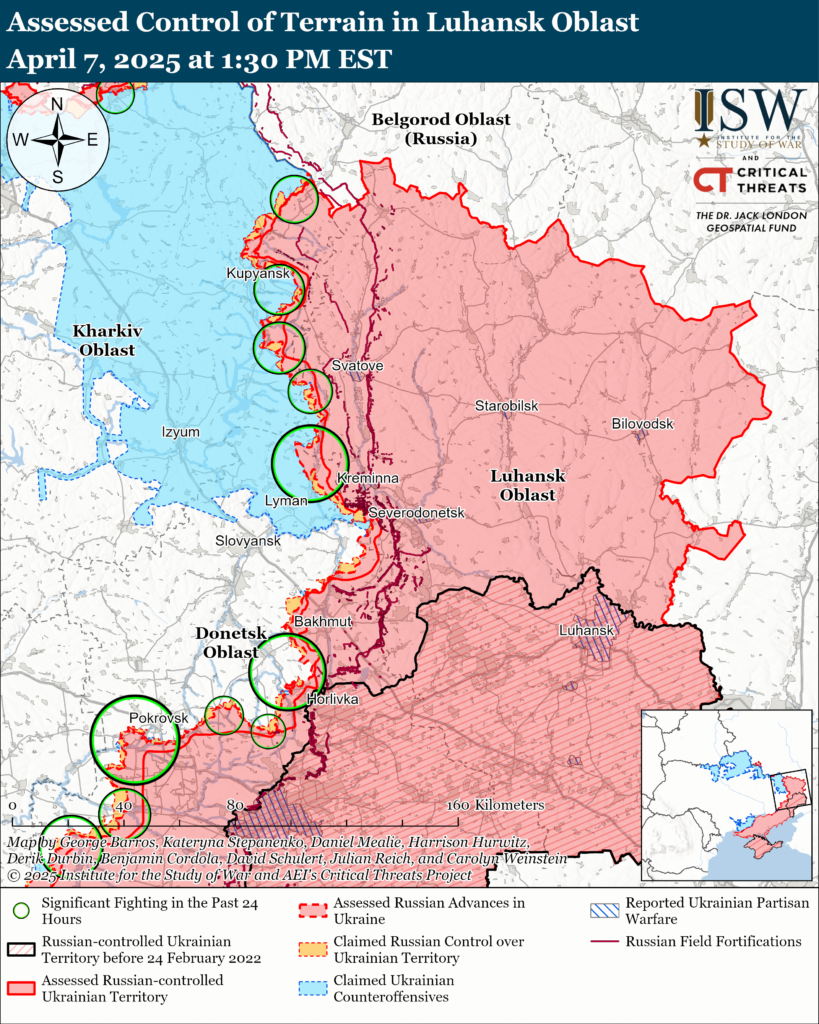
Russian forces continued offensive operations in the Kupyansk direction on April 7 but did not make confirmed advances.
Unconfirmed claims: Russian milbloggers claimed that Russian forces advanced west of Zapadne (north of Kupyansk) and toward Petropavlivka (east of Kupyansk) and Pishchane (southeast of Kupyansk).[44] Ukrainian military observer Kostyantyn Mashovets stated on April 7 that Russian forces have advanced several hundred meters east of Zapadne beyond the P-79 Kupyansk-Dvorchina road.[45]
Russian forces conducted offensive operations northeast of Kupyansk near the international border near Kamyanka and Fyholivka, north of Kupyansk near Mala Shapivka and Kindrashivka, east of Kupyansk near Petropavlivka, and southeast of Kupyansk near Pishchane and Stepova Novoselivka on April 6 and 7.[46] Mashovets stated on April 7 that Russian forces are attacking Ukrainian positions near Zapadne.[47] A Ukrainian drone regiment operating in Kupyansk direction reported that Russian forces attacked twice in the Kupyansk direction with tanks and infantry fighting vehicles (IFVs) between April 6 and 7.[48] The drone regiment stated that Ukrainian forces destroyed two tanks and damaged two IFVs.
The commander of a Ukrainian drone regiment operating in the Kupyansk direction reported on April 7 that Russian forces are trying to expand their bridgehead on the right (west) bank of the Oskil River near Dvorchina (north of Kupyansk).[49] The commander stated that Ukrainian forces have prevented Russian forces from establishing pontoon crossings on the Oskil River and that Ukrainian forces are striking Russian engineering equipment.
Order of Battle: Mashovets stated that elements of the Russian 25th Motorized Rifle Brigade (6th Combined Arms Army [CAA], Leningrad Military District [LMD]) are operating north of Kupyansk and that the brigade is operating without one of its regular battalions but with two attached separate rifle battalions.[50] Mashovets stated that elements of the 1007th and 1486th motorized rifle regiments (both comprised of mobilized personnel) and a battalion of the 1431st Motorized Rifle Regiment (11th Army Corps, LMD) are also operating north of Kupyansk. Mashovets stated that at least two battalions of the 27th Motorized Rifle Brigade (1st Guards Tank Army [GTA], Moscow Military District [MMD]) are operating near Lyman Pershyi (northeast of Kupyansk).
Russian forces continued offensive operations in the Borova direction on April 7 but did not advance.
Russian forces continued ground assaults north of Borova near Bohuslavka and toward Novoplatonivka, northeast of Borova near Zahryzove and Nova Kruhlyakivka, east of Borova near Nadiya, and southeast of Borova near Hrekivka, Novoserhiivka, and Novoyehorivka on April 6 and 7.[51] The Ukrainian Khortytsia Group of Forces reported that Russian forces conducted a mechanized assault of an unspecified echelon with armored vehicles and all-terrain vehicles (ATVs) near Bohuslavka.[52]
A Ukrainian drone regiment published footage on April 7 of a Ukrainian drone strike against a Russian Buk-M3 air defense system reportedly worth $100 million in an unspecified area of Luhansk Oblast.[53]
Order of Battle: Elements of the Russian 16th Guards Spetsnaz Brigade (Russian General Staff’s Main Directorate [GRU]) are reportedly operating in the Borova direction.[54]
Russian forces continued offensive operations in the Lyman direction on April 7 but did not make confirmed advanced.
Unconfirmed claims: The Russian Ministry of Defense (MoD) claimed that Russian forces seized Katerynivka (northeast of Lyman).[55] Russian milbloggers claimed that Russian forces advanced west of Balka Zhuravka (northeast of Lyman, south of Yampolivka (northeast of Lyman), near Nove (just southwest of Katerynivka), and in northern Torske (south of Yampolivka).[56]
Russian forces continued ground attacks northeast of Lyman near Balka Zhuravka, Novomykhailivka, Ridkodub, Nove, Kolodyazi, and Yampolivka, and east of Lyman near Torske on April 6 and 7.[57]
The commander of a Ukrainian drone company operating in the Lyman direction stated that Russian forces have intensified offensive operations and slightly shifted their main effort further north towards Hrekivka, Novomykhailivka, and Novolyubivka (all northeast of Lyman).[58] The commander stated that Russian forces still attack in small groups and recently began operating armored vehicles and attempting to establish pontoon bridges across the Zherebets River but are unsuccessful. Ukrainian military observer Kostyantyn Mashovets reported that Russian forces conducting offensive operations in the 25th CAA’s (Central Military District [CMD]) area of responsibility (AOR) on the east bank of the Zherebets River near Torske are struggling more than the Russian bridgehead on the west (right) bank of the Zherebets in the 20th CAA’s (MMD) AOR further north in the Novolyubivka area despite having a similar amount of forces.[59]
Order of Battle: Mashovets reported that elements of the 144th Motorized Rifle Division (20th CAA) are fighting west of Novolyubivka and toward Nove and Zelena Dolyna (northeast of Lyman).[60] Mashovets reported that elements of the 67th Motorized Rifle Division (25th CAA), including of its 164th Motorized Rifle Brigade, are fighting near Torske.[61]
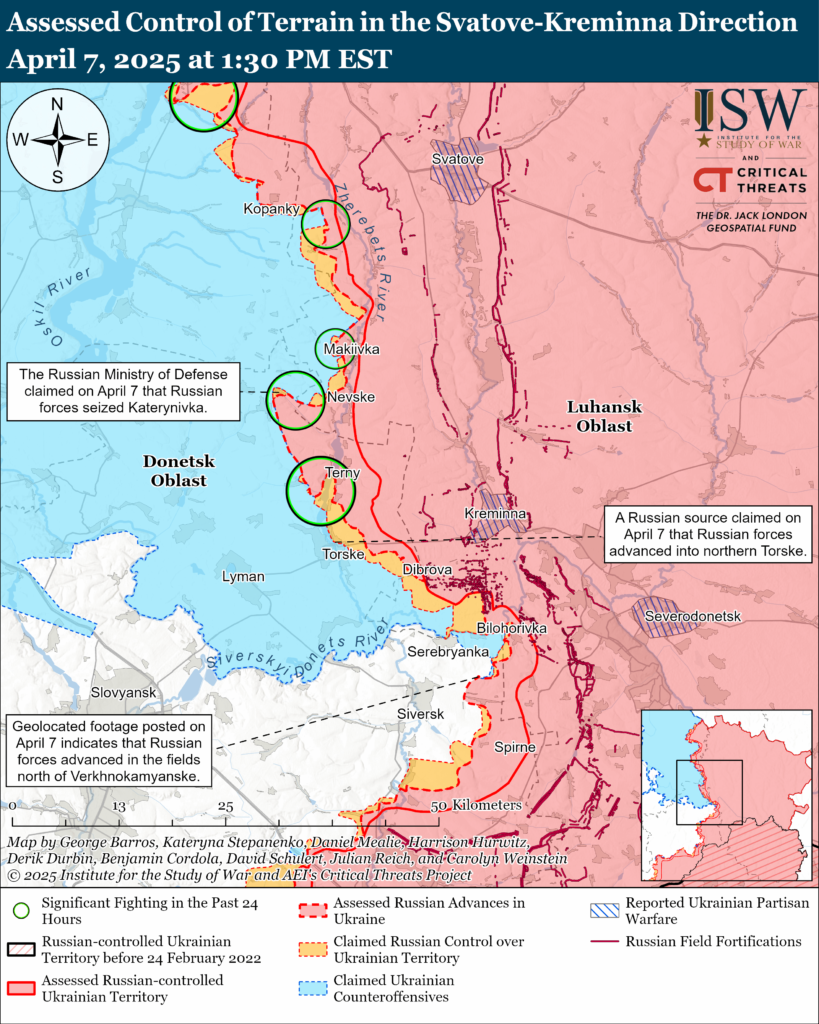
Russian Subordinate Main Effort #3 – Donetsk Oblast (Russian objective: Capture the entirety of Donetsk Oblast, the claimed territory of Russia’s proxies in Donbas)

Russian forces recently advanced in the Siversk direction.
Assessed Russian advances: Geolocated footage published on April 7 indicates that Russian forces recently advanced north of Verkhnokamyanske (east of Siversk).[62]
Russian forces attacked north of Siversk near Serebryanka, northeast of Siversk near Bilohorivka, and east of Siversk near Verkhnokamyanske on April 6 and 7.[63] A Russian milblogger claimed that Ukrainian forces counterattacked near Bilohorivka.[64]
Russian forces continued offensive operations in the Chasiv Yar direction on April 7 but did not advance.
Unconfirmed claims: A Russian milblogger claimed that Russian forces advanced in southwestern Chasiv Yar.[65]
Russian forces attacked near Chasiv Yar itself and southeast of Chasiv Yar near Kurdyumkivka on April 7.[66]
Order of Battle: Elements of the Russian 88th “Hispaniola” Volunteer Brigade (Russian Volunteer Corps) and the 98th Airborne (VDV) Division, including elements of its 217th and 331st VDV regiments and 215th Reconnaissance Battalion, are reportedly operating near Chasiv Yar.[67]
Russian forces recently advanced in the Toretsk direction.
Assessed Russian advances: Geolocated footage published on April 7 indicates that Russian forces recently advanced to the southwestern waste heap of the Tsentralna Mine in southwestern Toretsk.[68]
Unconfirmed claims: Russian milbloggers claimed that Russian forces advanced northeast of Toretsk near Krymske; east of Toretsk near Pivnichne; and southeast of Toretsk near Valentynivka, Panteleymonivka and Oleksandropil.[69]
Russian forces attacked near Toretsk itself, north of Toretsk near Dyliivka and Dachne, west of Toretsk near Shcherbynivka, southwest of Toretsk near Leonidivka and Romanivka, and southeast of Toretsk near Sukha Balka, Oleksandropil, and Valentynivka on April 6 and 7.[70]
The commander of a Ukrainian drone company operating in the Toretsk direction reported on April 7 that Russian forces are intensively using first-person view (FPV) drones with fiber optic cables while increasingly conducting guided glide bomb strikes.[71] The commander noted that Russian forces are not conducting guided glide bomb strikes against buildings in which both Russian and Ukrainian forces maintain positions but are using the strikes to identify other Ukrainian positions. The commander noted that Russian forces are attempting to use motorized equipment and that Russian forces have doubled their number of assaults as compared to last week (roughly March 30 to April 5).
Order of Battle: Ukrainian military observer Kostyantyn Mashovets reported on April 7 that elements of the Russian 150th Motorized Rifle Division (8th Combined Arms Army [CAA], Southern Military District [SMD]) are operating in Zabalka Microraion (southernmost Toretsk) and near Krymske .[72] Mashovets stated that elements of the Russian 132nd Motorized Rifle Brigade (51st CAA, formerly 1st Donetsk People’s Republic Army Corps [DNR AC], SMD), supported by elements of the 8th CAA, are operating near Panteleymonivka and Sukha Balka. Elements of the Russian 4th Motorized Rifle Brigade (3rd Combined Arms Army [CAA], formerly 2nd Luhansk People’s Republic [LNR] AC) are reportedly operating near Druzhba.[73]
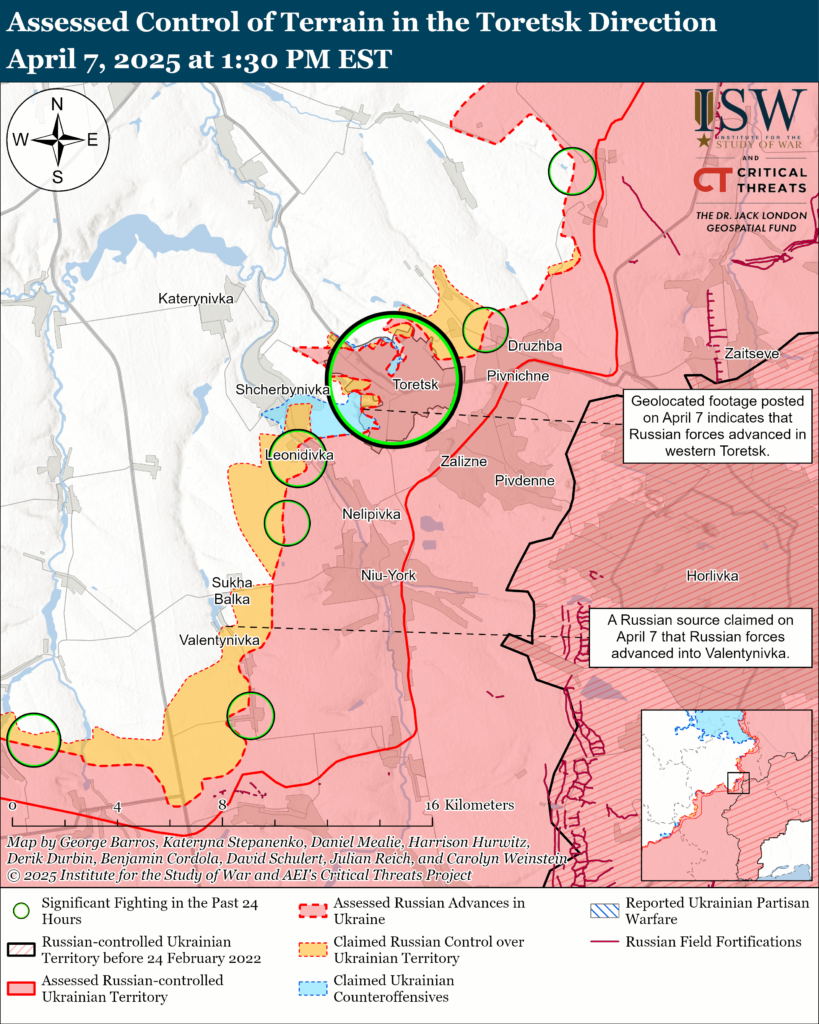
Russian forces recently advanced in the Pokrovsk direction.
Assessed Russian advances: Geolocated footage published on April 7 indicates that Russian forces recently marginally advanced in southwestern Uspenivka (southwest of Pokrovsk).[74] Geolocated footage published on April 5 and 7 indicates that Russian forces recently advanced in central and western Lysivka (south of Pokrovsk).[75]
Unconfirmed claims: Russian sources claimed that Russian forces operating southwest of Pokrovsk advanced west and north of Uspenivka, to northern Nadiivka, east of Kotlyarivka and Kotlyne, southeast of Bohdanivka, and in western Troitske.[76] Russian sources also claimed that Russian forces seized Uspenivka.[77] Russian milbloggers claimed that Russian forces occupy most of Troitske and that Ukrainian forces maintain positions in western Troitske.[78] A Russian source claimed that Russian forces occupy about half of Kotlyne.[79] Some Russian sources claimed that Russian forces operating southeast of Pokrovsk seized Lysivka, while others claimed that Russian forces occupy about one-third of Lysivka, that Ukrainian forces maintain positions in the western part of the settlement, and that central Lysivka is a contested “gray zone.”[80]
Russian forces attacked northeast of Pokrovsk near Tarasivka; east of Pokrovsk near Yelyzavetivka, Kalynove, and Vodyane Druhe; southeast of Pokrovsk near Lysivka; and southwest of Pokrovsk near Udachne, Kotlyarivka, Kotlyne, Uspenivka, Bohdanivka, and Kotlyne, and toward Serhiivka, Muravka, and Novooleksandrivka on April 6 and 7.[81] A Russian milblogger claimed that Ukrainian forces unsuccessfully counterattacked with drone support southwest of Pokrovsk near Solone.[82]
Ukrainian Khortytsia Group of Forces Spokesperson Colonel Viktor Trehubov stated that the intensity of fighting in the Pokrovsk direction alone is sometimes comparable to that along the entire frontline in eastern Ukraine.[83] Trehubov reiterated that Russian forces conducted a temporary pause in the Pokrovsk direction following heavy losses in early March 2025 but have since restored their combat capabilities. Trehubov stated that Russian forces are attempting to bypass Pokrovsk from the west and advance toward Novopalivka (southwest of Pokrovsk) and the T-0504 Pokrovsk-Kostyantynivka highway.
Order of Battle: Elements of the Russian 15th Motorized Rifle Brigade (2nd CAA, Central Military District [CMD]) are reportedly operating near Solone; elements of the Vanya Ivanov Group are reportedly operating near Kotlyne; and elements of the 90th Tank Division (41st CAA, CMD) are reportedly operating near Troitske.[84]
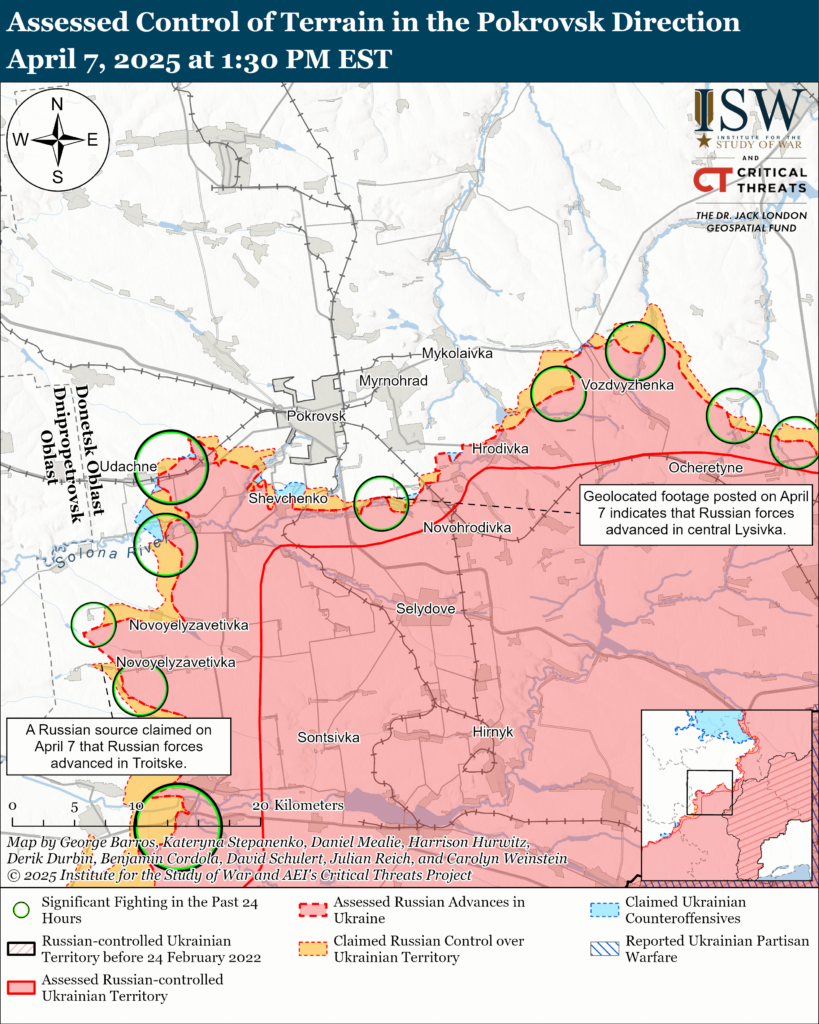
Russian forces continued offensive operations in the Kurakhove direction on April 7 but did not make confirmed advances.
Unconfirmed claims: Russian milbloggers claimed that Russian forces advanced near Kostyantynopil (west of Kurakhove) and from Rozlyv (southwest of Kurkahove) toward Bahatyr (northwest of Rozlyv).[85]
Russian forces conducted offensive operations west of Kurakhove near Andriivka and Kostyantynopil and southwest of Kurakhove near Rozlyv on April 6 and 7.[86]
Order of Battle: Elements of the Russian 37th Motorized Rifle Brigade (36th CAA, Eastern Military District [EMD]) and 40th Naval Infantry Brigade (Pacific Fleet) are reportedly operating in the Kurakhove direction.[87] Elements of the 36th Motorized Rifle Brigade (29th CAA, EMD) are reportedly striking Ukrainian positions in Bahatyr.[88]
Russian forces recently advanced in the Velyka Novosilka direction.
Assessed Russian advances: Geolocated footage published on April 6 indicates that Russian forces recently advanced northeast of Pryvilne (northwest of Velyka Novosilka).[89]
Unconfirmed claims: Russian sources claimed that Russian forces seized Prvyilne and advanced north of Vesele, near Burlatske (both northwest of Velyka Novosilka), and to the northeastern outskirts of Shevchenko (northwest of Burlatske).[90]
Russian forces conducted offensive operations north of Velyka Novosilka near Skudne and northwest of Velyka Novosilka near Vilne Pole, Pryvilne, Vesele, Fedorivka, and Burlatske on April 6 and 7.[91]
Order of Battle: Elements of the Russian 57th Motorized Rifle Brigade (5th CAA, EMD) are reportedly operating near Shevchenko; elements of the 5th Tank Brigade (36th CAA, EMD) are reportedly operating in the direction of Komar (north of Velyka Novosilka); and elements of the 37th Motorized Rifle Brigade (36th CAA, EMD) are reportedly striking Ukrainian positions in Komar.[92] Elements of the 36th Motorized Rifle Brigade (29th CAA, EMD), 14th Spetsnaz Brigade (Russian General Staff’s Main Directorate [GRU]), and 140th Anti-Aircraft Missile Brigade (29th CAA, EMD) are reportedly operating in the Shakhtarske (Velyka Novosilka) direction.[93] Drone operators of the 30th Spetsnaz Company (reportedly of the 36th CAA, EMD) are reportedly operating in the Shakhtarske (Velyka Novosilka) direction.[94]
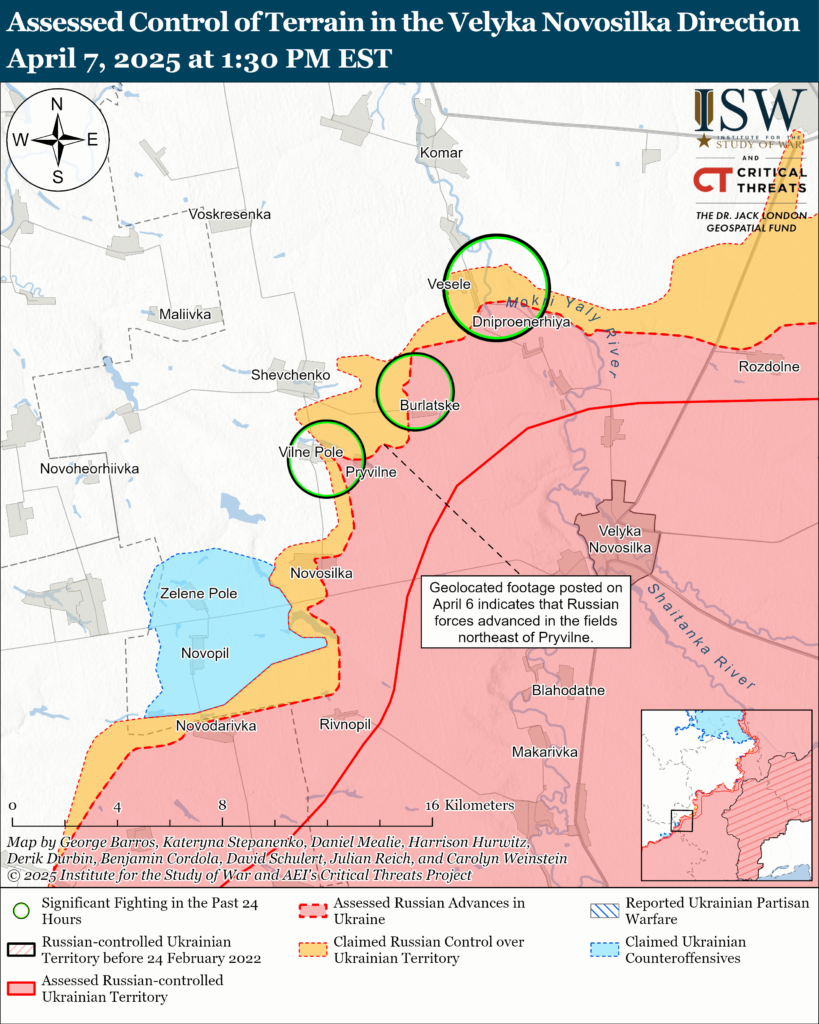
Russian Supporting Effort – Southern Axis (Russian objective: Maintain frontline positions and secure rear areas against Ukrainian strikes)
Russian forces recently advanced in western Zaporizhia Oblast.
Assessed Russian advances: Geolocated footage posted on April 7 indicates that Russian forces recently advanced to western Stepove (northwest of Robotyne).[95]
Unconfirmed claims: Russian milbloggers claimed that Russian forces advanced northwest and northeast of Shcherbaky and southeast of Kamyanske (both northwest of Robotyne).[96]
Russian forces conducted offensive operations northwest of Robotyne near Mali Shcherbaky, Shcherbaky, and Kamyanske on April 6 and 7.[97] A Russian milblogger claimed that Ukrainian forces are counterattacking near Shcherbaky.[98]
Ukrainian state energy company Enerhoatom Head Petro Kotin stated to The Guardian in an article published on April 6 that it would be unsafe for Russia to restart the Russian-occupied Zaporizhzhia Nuclear Power Plant (ZNPP) as Russia would have to overcome major problems, including insufficient cooling water, personnel, and electricity supplies.[99] Kotin noted that it is impossible for Russia to restart even one unit reactor of the ZNPP during wartime as it would take Ukraine between two months and two years to restart the ZNPP. Kotin stated that Enerhoatom is prepared to restart the ZNPP but Russian forces must leave, demine, and demilitarize the area.
Order of Battle: Drone operators of the Russian 291st Motorized Rifle Regiment (42nd Motorized Rifle Division, 58th CAA, SMD) are reportedly operating near Novodanylivka (north of Robotyne), and drone operators of the Russian 503rd Motorized Rifle Regiment (19th Motorized Rifle Division, 58th CAA, SMD) are reportedly operating in the Orikhiv direction.[100] Drone operators of the Russian ”BOBR” Rapid Response Drone detachment are reportedly operating in Zaporizhia Oblast.[101]
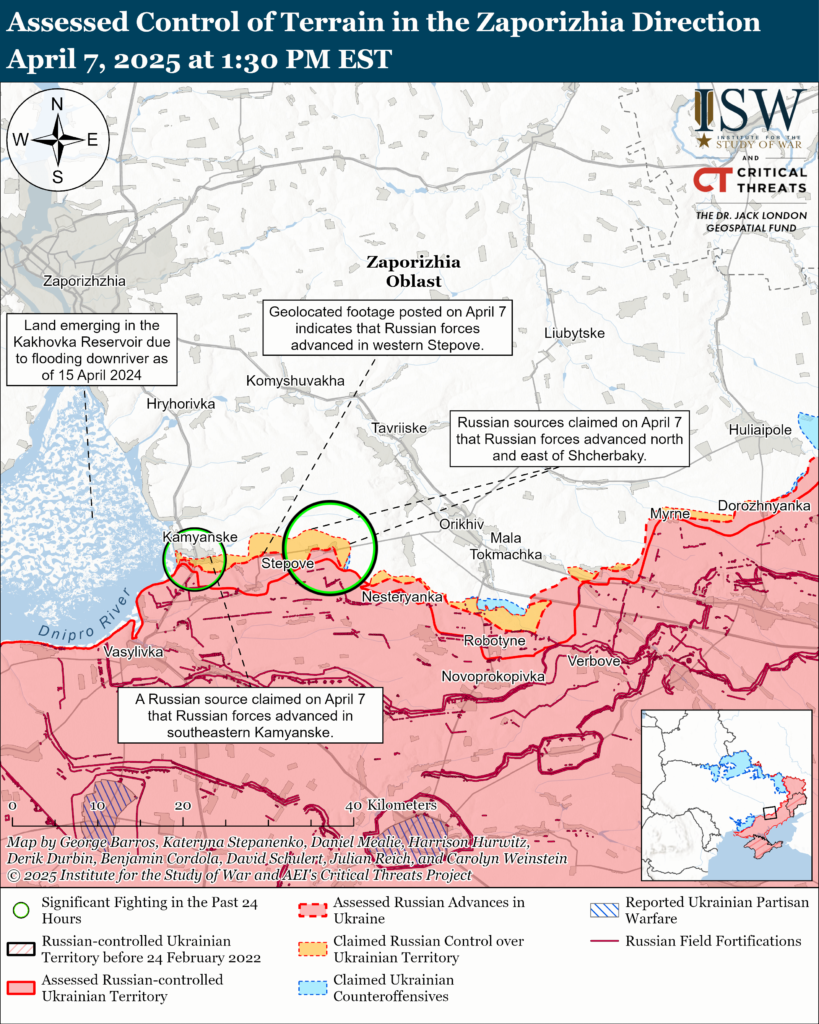
Russian forces conducted limited offensive operations in the Dnipro direction on April 6 and 7 but did not advance.[102]
Order of Battle: Drone operators of the Russian 61st Naval Infantry Brigade (Northern Fleet) are reportedly striking Ukrainian forces on the west (right) bank of the Dnipro River.[103]
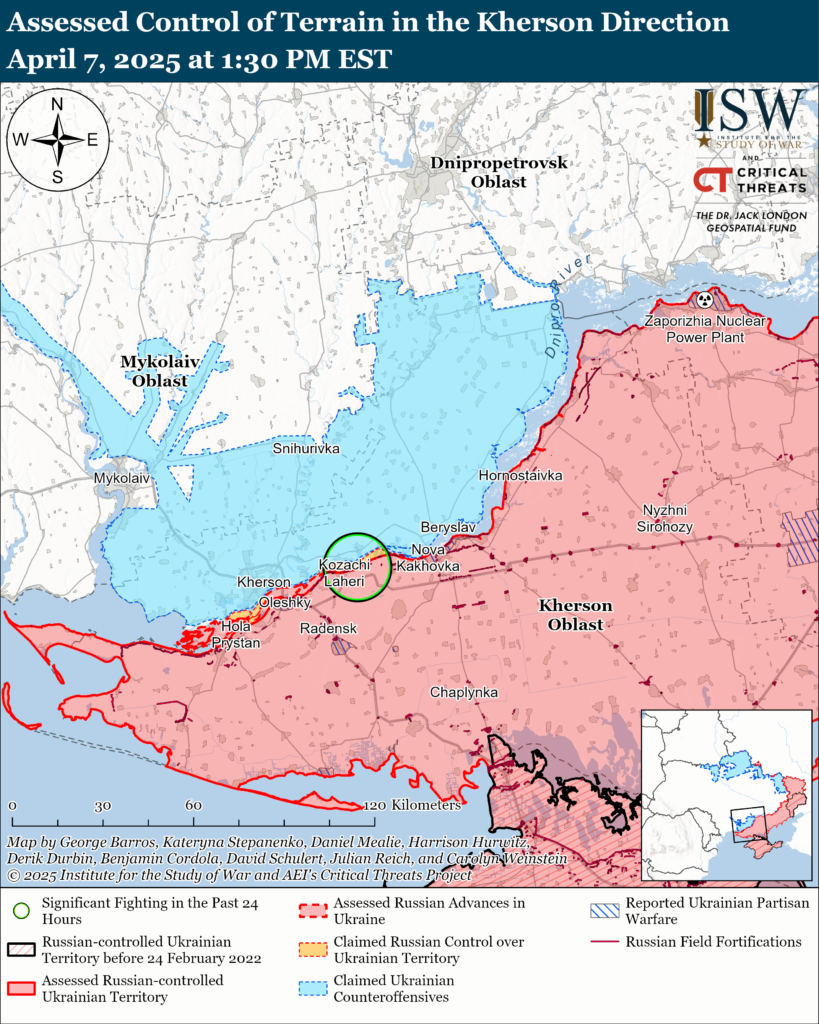
Russian Air, Missile, and Drone Campaign (Russian Objective: Target Ukrainian military and civilian infrastructure in the rear and on the frontline)
See topline text.
Russian Mobilization and Force Generation Efforts (Russian objective: Expand combat power without conducting general mobilization)
The Kremlin continues to use its “Time of Heroes” program to militarize regional governments and society in occupied Ukraine. Crimea occupation head Sergei Aksyonov stated on April 7 that Russian war veteran Anton Starostin completed an internship in the occupation government in Crimea as part of the “Time of Heroes” program and became the Deputy Chairperson of the State Committee for Youth Policy in occupied Crimea.[104]
Russian business outlet Kommersant reported on April 7 that the Russian Prosecutor General’s Office filed a lawsuit to transfer assets worth 79 billion rubles (about $917 million) of JSC Sayanskkimplast, Russia’s largest producer of polyvinyl chloride (PVC), to the Russian state.[105]
Russian Technological Adaptations (Russian objective: Introduce technological innovations to optimize systems for use in Ukraine)
Ukraine’s Main Military Intelligence Directorate (GUR) reported on April 7 that Ukraine identified an Indian-produced component in an unspecified Russian weapon for the first time.[106]
Activities in Russian-occupied areas (Russian objective: Consolidate administrative control of annexed areas; forcibly integrate Ukrainian citizens into Russian sociocultural, economic, military, and governance systems)
ISW is suspending occupation coverage in its daily Russian Offensive Campaign Assessments. ISW is introducing a new product line tracking activities in Russian-occupied areas of Ukraine. The occupation updates will examine Russian efforts to consolidate administrative control of annexed areas and forcibly integrate Ukrainian citizens into Russian sociocultural, economic, military, and governance systems.
Significant activity in Belarus (Russian efforts to increase its military presence in Belarus and further integrate Belarus into Russian-favorable frameworks)
Russia continues efforts to expand control over Belarus through the Union State framework. Belarusian Prime Minister Alexander Turchin arrived in Moscow on April 7 to hold talks with Russian Prime Minister Mikhail Mishustin about import substitution projects and unifying Russian and Belarusian energy markets, industrial policy, and transportation market regulations.[107]
Note: ISW does not receive any classified material from any source, uses only publicly available information, and draws extensively on Russian, Ukrainian, and Western reporting and social media as well as commercially available satellite imagery and other geospatial data as the basis for these reports. References to all sources used are provided in the endnotes of each update.
 Eurasia Press & News
Eurasia Press & News
